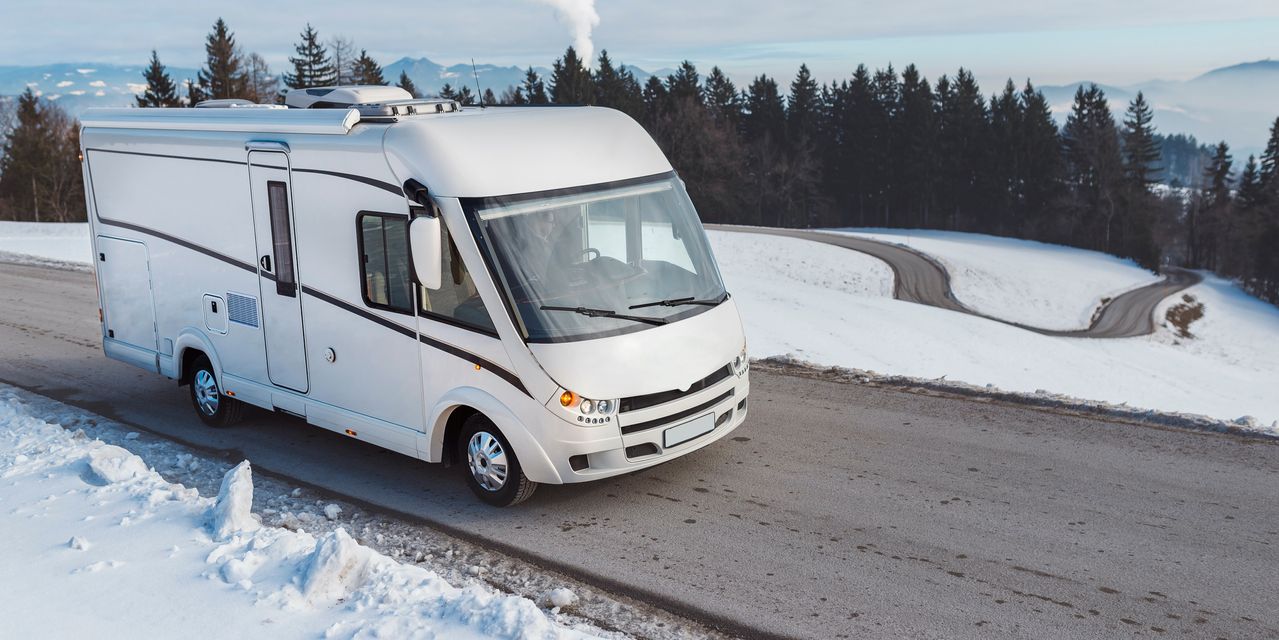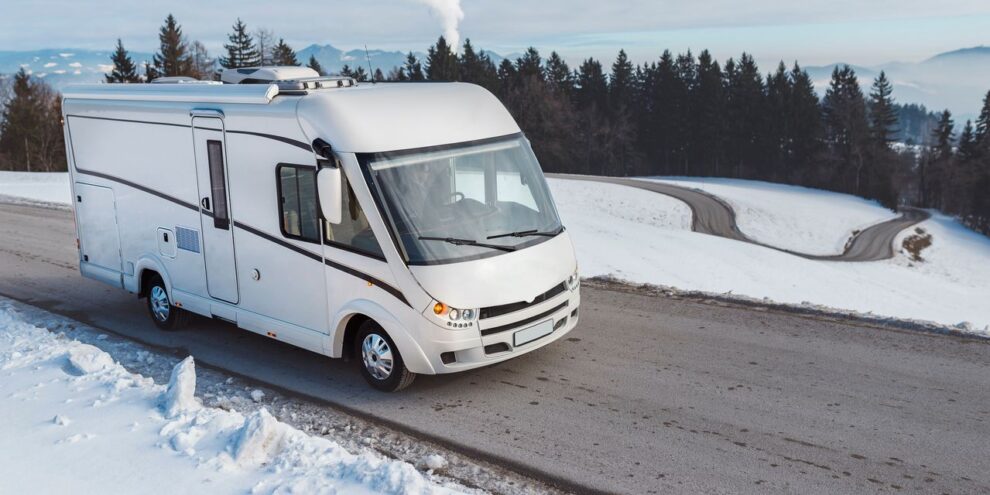
This article is reprinted by permission from NerdWallet.
Winter RV road trips are more popular than ever this year as people look for socially-distanced vacations that don’t involve airplanes or hotels.
For some travelers, a winter RV road trip in 2020 might mean driving to grandma’s house for the holidays but sleeping in your RV rather than a bedroom there. For others, it’s an opportunity to stay away from people and ditch the Christmas tree in favor of living trees.
But while renting an RV for a road trip might seem like a safer alternative to traditional travel in the midst of COVID-19, winter RV road trips present their own challenges. Here are 10 things to know before taking your RV out in the snow:
1. Decide whether your RV needs to be winterized — and learn what that actually means
You’ll probably see the phrase “winterizing your RV” when planning a road trip someplace chilly. Your task is to figure out if your RV has already been winterized, and whether it needs to be.
Winterizing your RV means you’ve taken steps such as:
- Emptying water tanks.
- Draining the water heater and water lines.
- Disabling plumbing in order to prevent the pipes (which run along the undercarriage of the RV) from bursting or being destroyed.
If you’re traveling someplace where temperatures are going to get below freezing, you’ll need to winterize your RV. It’s a process you can do yourself, though your local RV company may also be willing to do it for you.
“If you’re traveling in a cold weather state, chances are the vehicle you’re renting will be winterized before you take it out on the road,” says Jennifer Young, co-founder of RV rental site Outdoorsy.
But winterizing your RV is not always a must-do, especially if temperatures at your cold destination won’t actually get below freezing. If a vehicle has been winterized, you won’t be able to use the sink or bathroom inside the RV as usual (unless you take extra steps like using antifreeze).
2. Get the right heater
If your campsite is hooked up to electricity, then an electric heater is your best bet to save money. But if you’re camping somewhere without an electric hookup, avoid using the onboard heat systems. That’s because most onboard heating systems use propane, which JP Smith, full-time RV traveler and founder of the Ultimate RV Checklist app, warns will last only a couple of days.
Also see: Some people can earn as much as $60,000 a year with this pandemic side hustle
A small, portable propane heater “will do the same job and only ‘sips’ propane compared to guzzling it,” he says. “It’s also plenty for the smaller spaces of RVs.”
As far as the RV’s built-in furnace, keep it clean by using compressed air or a soft brush to remove debris. Otherwise, obstructions may prevent air from flowing properly.
3. Insulate your RV properly
With the right insulation, you may not need to worry about a separate heater at all. Good insulation might also mean not needing to wear a heavy jacket indoors or using a sleeping bag every night. Some options include:
Don’t forget the slide outs: If your RV has slide outs (a cut-out portion of your RV that increases the living space available), RV blogger Ashley Mann recommends placing a foam board of insulation underneath each of your RV slides to reduce drafts. “Just don’t forget to remove the foam before pulling in your slides,” she warns.
Consider an RV skirt: It’s exactly what it sounds like — a skirt, often made of vinyl, that wraps around your RV. By creating a barrier of insulated air, the skirt is designed to keep the RV warmer inside. In turn, that helps prevent pipes from freezing, while allowing you to burn less propane (thus saving energy and money). RV skirts generally can cost as low as $150, but can cost thousands of dollars, depending on factors like quality and whether you need custom sizing.
Don’t have an RV skirt? “In a pinch, you can also pack snow around the battery bays,” advises travel blogger Taryn Shorr. “It’s a shockingly efficient natural insulator.”
4. Prepare your pipes and tanks so they don’t freeze
It’s not just you who needs to stay warm: Your RV’s pipes need protection from the freezing cold too. Water leftover in pipes and hoses can turn to ice and expand, which can cause them to crack or burst.
Travel blogger Bettina Staerkle learned it the hard way during a winter trip through Alberta, Canada. The hot water tank froze and burst, flooding the inside of her RV.
If you’re traveling in an RV on only a few cold nights a year, Staerkle said an easy method to prevent pipes from freezing is to keep a faucet slowly running through the night, allowing the water to constantly move through the pipes. Moving water requires a lower temperature to freeze than sitting water.
You might like: Traveling with Fido? How to find a pet-friendly hotel
Another easy alternative is to purchase heat tape, which you wrap around your RV water hose. Plug the tape into a power source, and the tape will remain heated as long as it is plugged in, keeping the hose warm.
5. Check your tires
If your RV doesn’t have snow tires and you’re planning to drive through icy road conditions, make sure you have a set of snow chains. In fact, driving with snow chains during adverse weather conditions is a requirement on some roads.
But depending on where your RV came from, you might not even be able to drive on those roads. Many big RV rental companies, such as Cruise America, explicitly prohibit renters from using chains on their motorhomes, as they can cause damage.
6. Pack the right gear
While you want to avoid overpacking, sometimes winter can call for a few extra items. Consider packing:
- Vent insulator pillows: A $10 to $40 pillow that you insert into openings like roof vents to keep warm air in and cold air out. “When we first started RVing, we didn’t realize just how much heat was escaping from our living room through the vents,” says travel blogger Laura Peters. “These cheap pillows saved us hundreds of dollars on heating throughout the winter and we highly recommend them to any first-timers.”
- Apps to check the weather and road conditions: Apps like Weather Hi-Def Radar include snowfall and wind speed maps, which might be particularly helpful when driving an RV in the winter.
- Gear to keep you warm: Pack electric blankets, hand warmer packets and waterproof, windproof clothing.
- Slippers: You probably don’t want to be walking around your RV in dirty or snowy shoes; slippers can protect your feet from cold floors.
- A snow shovel and ice scraper: You might need to dig out your RV and scrape ice from your windows when it’s time to drive.
- Extra emergency items: Whether it’s additional driving equipment like chains or camping goods like canned food, make an exception to the “don’t overpack” rule when it’s in the name of emergency supplies.
7. Keep cold air from coming in the windows
You might not get to wake up to a winter wonderland, but keeping the shades closed when it’s snowy will keep you warmer.
“It sounds counterintuitive, but the extra layer creates an air gap from the window and keeps some of the cold away from entering the main coach,” says Jerome Braga, who has been traveling in his RV since 2015.
As far as the windows themselves, make sure they’re properly insulated.
See: The 12 best American road trips
“Insulating the windows with a plastic film that shrinks when you heat it makes a big difference in reducing heat loss,” says Ashley Mann, who runs the RV Inspiration blog.
8. Check the campground schedule
If you like to drive without an itinerary and stop whenever you feel like it, you’ll still need to do some planning. Many campgrounds close in winter, so verify potential campsite locations are open before you hit the road.
But even if a campground looks officially closed online, it doesn’t hurt to call.
“Many campgrounds and RV parks that close in winter will accept campers on a day-by-day basis,” says Damian Tysdal of the Safe Travels podcast. “They don’t want to be ‘officially’ open, but are often around and are willing to have campers.”
9. Drive carefully
Driving an RV in harsh winter weather requires the same common sense you need to drive an RV any other day: Slow down and avoid being on the road when it’s dark.
But winter brings new variables: Motorhomes typically have rear-wheel drive (as opposed to front-wheel drive in most passenger vehicles), so the brakes will handle differently on slippery roads than what you’re used to. With RVs, it’s even more important that you ease on the brakes, and leave plenty of room between you and the vehicle ahead.
And when driving in snowy conditions, put your headlights on the low beam setting. “The brighter your lights are, the harder it will be for you to see through the snow and keep your eyes on the road,” Young warns.
10. Head south
When all else fails, set your GPS to go south. At least that’s the advice of full-time RV traveler Michelle Fishburne.
“Just the thought of road ice and an RV causes me to flinch and brings back scary images of when my father tried to control the slide of our car as ice got the better of us. We camped in a parking lot because it was too dangerous to continue driving,” she says. “I’ll skip the stress and the potential for standing in the frigid, snowy air as I call for help.”
Fishburne drives throughout the U.S., but her winter route will take her from Raleigh, North Carolina, through Texas and Arizona, and will eventually end up in San Diego, California.
Also on MarketWatch: Coronavirus has hurt charitable giving and sent need soaring. Here are some tax-advantaged giving strategies you might not know about
“If you aren’t accustomed to driving on ice and snow in your car, don’t even think about trying it in a motorhome,” she says.
The bottom line
A winter RV road trip can be a grand adventure, and a refreshing way to travel in nature without having to get on an airplane or ending up in a busy hotel lobby. Pack your own food to make on the stovetop and marshmallows to roast over the fire, and you won’t even have to enter a restaurant.
But a cold-weather RV road trip presents its own set of unique challenges: You’ll need to make sure your RV is set to handle winter conditions, and you’ll have to track down additional winter gear and take extra precautions when driving and camping that a warmer destination wouldn’t necessarily require.
If all else fails, you can always take your RV out this winter, but head south for a warm-weather getaway.
More From NerdWallet
Sally French is a writer at NerdWallet. Email: [email protected]. Twitter: @SAFmedia.






